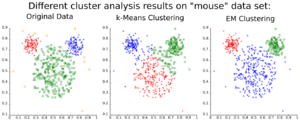Cluster analysis facts for kids
Clustering (also called cluster analysis) is a way of organizing information. Imagine you have a big pile of different toys. Clustering is like sorting those toys into groups. Toys in the same group are very similar to each other. But they are different from toys in other groups.
For example, you might put all the cars in one group. All the action figures go into another group. And all the building blocks go into a third group. This helps us understand the toys better. In computers, clustering helps us find patterns in large amounts of data. It is a common job in data mining.
Contents
What is Clustering?
Clustering is a method used in data analysis. It helps us find hidden groups within a set of information. These groups are called clusters. The main idea is to put things that are alike together. Things that are not alike go into different groups.
How Does Clustering Work?
Computers look at different features of the data. For example, if you have information about students, features could be their age, height, or favorite subjects. The computer then tries to find students who are similar in these features.
- Finding Similarities: The computer measures how similar two things are. It might use numbers or other ways to compare them.
- Making Groups: Based on these similarities, the computer starts forming groups. It keeps adding things to a group if they are similar enough to what is already there.
- Different from Others: Once a group is formed, its members are more similar to each other than to anything in another group.
Why Do We Use Clustering?
Clustering is very useful for making sense of large amounts of data. It helps us discover patterns that we might not see easily.
- Understanding Data: It helps us see how different pieces of information are related.
- Making Decisions: Businesses use it to understand their customers better. This helps them make better products or services.
- Finding New Things: Scientists use it to find new types of stars or diseases.
Where is Clustering Used?
Clustering is used in many different areas. It helps people and computers organize and understand information.
In Marketing
Companies use clustering to group their customers.
- They might group customers by age, what they buy, or how often they shop.
- This helps companies create special ads for each group.
- It also helps them offer products that specific groups might like.
In Science
Scientists use clustering to study many things.
- Biology: They can group different types of plants or animals. They also group genes that work together.
- Astronomy: Scientists use it to find groups of stars or galaxies.
- Medicine: Doctors can group patients with similar symptoms. This helps them understand diseases better.
In Everyday Life
You might see clustering used without even knowing it.
- News Articles: News websites group articles about the same topic together.
- Music Playlists: Music apps might group songs that sound similar.
- Image Search: When you search for images, the computer might group similar pictures.
Types of Clustering
There are many ways to do clustering. Different methods work best for different kinds of data.
Hierarchical Clustering
This method builds a tree-like structure of clusters.
- It can start with every item in its own group. Then it slowly joins the most similar groups together.
- Or, it can start with one big group. Then it splits that group into smaller and smaller ones.
- This method helps you see how groups are related to each other.
Partitioning Clustering
This method divides data into a set number of groups.
- One popular way is called "K-means clustering."
- You tell the computer how many groups (K) you want.
- The computer then tries to put each item into the closest group.
- It keeps moving items around until the groups are as good as they can be.
See also
 In Spanish: Análisis de grupos para niños
In Spanish: Análisis de grupos para niños


